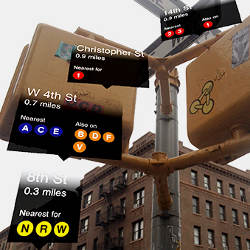
Augmenting the real environment with additional information is an idea prospected for over two decades within the augmented reality (AR) research community. When deployed in outdoor environments, virtual information overlays enable a wide range of applications, from tourist guides and pedestrian navigation to urban gaming. The number of people aware of augmented reality is increasing, in part due to growing media coverage.
Commercially, mobile AR is experienced primarily through augmented reality browsers that augment the physical environment with digital information associated with geographical locations or real objects by using smartphones with camera, GPS, and compass sensors. While still relatively small in the mobile applications landscape, AR technology has nevertheless become a noticeable player. AR browsers have achieved more than 20 million downloads from mobile app stores, and some are even preinstalled on smartphones.
The first example of a mobile AR browser running in an outdoor environment was the Touring Machine, developed in 1997 by Feiner et al.1 Like the Touring Machine, the first generation of commercial AR browsers that came out in 2008 provided graphical augmentation based on geographic location and viewpoint information delivered from integrated sensors such as GPS, compass, and gyroscopes. The second generation of AR browsers are now able to link virtual content to physical objects of our everyday life (for example, magazines, posters, advertisements) using computer vision-based recognition and tracking techniques.
Will people use an AR browser for navigating to a restaurant, or a mobile map application?
The next generation of AR browsers may use a head-mounted display, like a future, more immersive version of Google Glass, which offers new possibilities for personal information systems that move beyond handheld devices.
Only Gadgets?
Despite this evolution it is still unclear how AR browser technology has been received or adopted by end users and whether this technology will move beyond being a gadget to become an important everyday product. While AR browsers should enable users to easily relate digital information to a real-world context they still must prove they can actually fulfill this promise, especially as competing solutions such as location-based services using digital maps are well established and rather intuitive. Will people use an AR browser for navigating to a restaurant, or a mobile map application?
In the few studies that have investigated the usage of current AR browsers2,3 the overall findings have been rather negative. Users perceived the technology more as a gadget than a must-have application. While these studies highlighted the critical lack of interesting content, they also identified other major issues. Failing to address these shortcomings may prevent AR technology from achieving mass-market adoption.
In this Viewpoint, we will discuss some of these issues that, in our opinion, should be addressed by companies and researchers in the field. Our observations are based on examining how lessons learned from the evolution of the Web and Web browsers can be reflected in the development of AR browsers.
Content as the Key to Success?
For any type of browser the most important criteria are the amount and variety of information that can be accessed. Some of the most popular AR browsers (for example, Layar,a Junaio,b and Wikitudec) only support content created for that specific browser or converted from popular online databases (for example, Wikipedia). The resulting browser-specific content is then generally grouped into hundreds of information “layers.” Similar to the early days of the Web that started with hundreds of HTML pages, the amount of AR-accessible content is still low compared to the information provided through current Web services (for example, Twitter, Flickr, YouTube). The available content is even sparser when you consider it geographically distributed over the entire planet.
One of the reasons for this is the content accessible through AR browsers is still widely separated from existing content accessible through standard Web browsers. The business plan of most companies in the field has them acting as gatekeeper for the available information, and this status is manifested by using proprietary formats that differ between the various AR browsers—unlike desktop browsers. From a content provider’s point of view this requires them to author the content differently for each of the various AR browsers.
Another negative aspect of current AR browsers is the basic nature of displayed information: primarily text with a limited amount of pictures and even less 3D content. This is in sharp contrast to the current richness of the non-AR Web experience in terms of media form, dynamics, design, and quality.
In our view, lessons should be learned from the rise of Web 2.0. Firstly, standardized formats, architectures, and protocols should be developed to describe the content structure. Standards organizations such as Khronos, X3D, OGC, and W3Cd have already made an effort toward conceptualizing and defining AR, but this work is still in a preliminary phase. Some research groups have tried to establish formats such as ARML (Augmented Reality Markup Language) or KARML (an AR extension to KML), yet there is no agreed-upon and widely implemented standard for describing content in AR. The KHARMA architecture implemented in the Argon browser4 is an early, but not yet commonly adopted, model for an AR web infrastructure.
Secondly, the availability of accepted standards enables the combination of content from various sources, forming a more valuable information product: the AR mashup. This would narrow the gap between the information in the Web and the content produced for AR browsers.
Finally, Web 2.0 has revealed the advantages of user-generated content. Currently, end-user authoring of content is only supported through a desktop interface, but there will be significant benefit for AR browsers if content generation can happen spontaneously and in-situ.
More than a Browser
In addition to improvements in the AR browser software, there are changes that could be made in low-level software and hardware that will significantly improve the user experience. To precisely augment the environment with digital information AR needs reliable tracking technology. Depending on the application, a wide range of different tracking methods has been developed. AR browsers currently support sensor-based tracking and, more recently, vision-based tracking. However, these tracking techniques are generally used side-by-side but not tightly combined. This results in digital information that is registered in different reference-spaces (for example, geo-referenced or object-referenced).
Easier access to software components providing fused sensor results is needed to make information access more practical for the developers. This will also allow better integration of more precise six degrees of freedom tracking technology that will improve the AR browser experience. This is an important area of research being explored by a number of AR research labs.
This tracking flexibility can be delivered either by AR browser companies or by hardware manufacturers who are showing increasingly interest in tracking technology.
Another aspect that could benefit from hardware manufacturer engagement is power management for AR. So far, AR browsers are rarely used for longer than several minutes. Due to the use of multiple energy-intensive hardware components (3D graphics, video, sensors), an AR application will drain a smartphone battery very quickly. To support an increasing use of AR technology, more efforts are needed from phone manufacturers to develop high-capacity batteries and energy-efficient sensors and algorithms.
Future Outlook
What if enough AR content would become available everywhere? Think back to when the number of Web pages dramatically increased due to the growing interest in the Web by companies and consumers in the late 1990s. What if standards are established and future tracking technologies allow for accurate augmentation in arbitrary environments? Would an AR browser then be the ultimate digital interface to the real world? Doubts remain that this would be the case. Preliminary research indicates users like that contextually relevant information is available at a certain locations, but could not agree on a single optimal technique for presenting it.3 When displaying mainly 2D content that is registered to points, users might prefer 2D map interfaces over AR browsers.
Companies have been mainly focusing on solving technical issues and hoping designers and end users produce the content and use-cases for their application. However, AR browsers still lack support for a broad range of applications or tasks within the browsers. While the Web has evolved and is now supporting a wide range of tasks and applications through dedicated Web interfaces (for example, communication, business, social networking), AR browsers so far only allow a single task: passive information browsing.
Conclusion
Current AR browsers are mainly used by people who want to try out the technology. For these current users, AR browsers may be more like a gadget. However, as AR researchers, we still see a huge potential and interest in the technology, which is shown by the increasing number of downloaded AR browsers.
In this Viewpoint, we discussed some of the issues we see in the current implementations of augmented reality browsers. Some of these limitations—such as the lack of rich content or obvious use cases—can be addressed by the AR browser companies and a growing community of users. This will hopefully permit this technology similar widespread adoption as the Web 2.0. Other problems such as energy efficiency or improved tracking will affect the usage of the future generation of AR browsers, but are more difficult to solve and require the involvement of hardware manufacturers.
Finally, further research is needed on how to seamlessly connect any real object in our environment with digital content to bring us closer to the ultimate digital interface to the real world.
Figures
 Figure. An AR browser application links geographical location of the real world (point of interest) with digital content (text labels): the information is spatially registered in the environment when seen through the camera view of a smartphone.
Figure. An AR browser application links geographical location of the real world (point of interest) with digital content (text labels): the information is spatially registered in the environment when seen through the camera view of a smartphone.
 Figure. An AR browser view of a New York City street intersection with subway information and distance overlays displayed.
Figure. An AR browser view of a New York City street intersection with subway information and distance overlays displayed.



Join the Discussion (0)
Become a Member or Sign In to Post a Comment